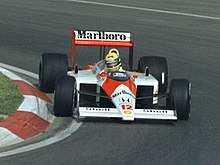Formula One
[1] With the average annual cost of running a team—designing, building, and maintaining cars, pay, transport—at approximately £220 million,[2] Formula One's financial and political battles are widely reported.[8] Giuseppe Farina, competing for Alfa Romeo, won the first Drivers' World Championship, narrowly defeating his teammate Juan Manuel Fangio.In the late 1970s, Lotus introduced ground-effect aerodynamics, previously used on Jim Hall's Chaparral 2J in 1970, that provided enormous downforce and greatly increased cornering speeds.The objective was to reduce cornering speeds and produce racing similar to rainy conditions by enforcing a smaller contact patch between tyre and track.[37] Schumacher's championship streak ended on 25 September 2005, when Renault driver Fernando Alonso became Formula One's youngest champion at that time (until Lewis Hamilton in 2008 and followed by Sebastian Vettel in 2010).Despite the entry of these new teams, the proposed cost-cap was repealed and these teams—which did not have the budgets of the midfield and top-order teams—ran around at the back of the field until they collapsed; HRT in 2012, Caterham (formerly Lotus) in 2014 and Manor (formerly Virgin, then Marussia), having survived falling into administration in 2014, at the end of 2016.[67] In 2022, the F1 governing body announced a major rule and car design change intended to promote closer racing through the use of ground effects, new aerodynamics, larger wheels with low-profile tyres, and redesigned nose and wing regulations.[81] The regulations governing Formula One are set to be revised for the 2026 season, with big changes planned to help encourage closer and more competitive racing.This approach lasted until the end of 2002 before the rules were changed again because the teams were not running in the early part of the session to take advantage of better track conditions later on.[105] The system was first implemented during the 2015 Monaco Grand Prix, before being upgraded to a full safety car, following a collision between Max Verstappen and Romain Grosjean.The safety car is another relatively recent innovation that reduced the need to deploy the red flag, allowing races to be completed on time for a growing international live television audience.Each competitor must be in the possession of a FIA Super Licence to compete in a Grand Prix,[127] which is issued to drivers who have met the criteria of success in junior motorsport categories and having achieved 300 kilometres (190 mi) of running in a Formula One car.Jochen Rindt is the only posthumous World Champion, after his points total was not surpassed despite his fatal accident at the 1970 Italian Grand Prix, with 4 races still remaining in the season.[138] Driving in Formula One is highly demanding physically, with drivers typically burning around 1,000 calories per hour and losing 2–4 kg (4–9 lb) of weight per race.[139] Drivers also need to train on cardiovascular fitness since heart rates can average more than 170 bpm during a race, this is more than a healthy adult would typically experience while running.British F3 has supplied many F1 drivers, with champions, including Nigel Mansell, Ayrton Senna and Mika Häkkinen having moved straight from that series to Formula One, and Max Verstappen made his F1 debut following a single season in European F3.The Monaco Grand Prix was first held in 1929 and has run continuously since 1955 (with the exception of 2020) and is widely considered to be one of the most important and prestigious automobile races in the world.Since 2008, the Formula One Group has been targeting new "destination cities" to expand its global reach, with the aim to produce races from countries that have not previously been involved in the sport.The race teams take advantage of this by placing this ballast at the extreme bottom of the chassis, thereby locating the centre of gravity as low as possible in order to improve handling and weight transfer.This is provided by "wings" mounted at the front and rear of the vehicle, and by ground effect created by low air pressure under the flat bottom of the car.Such high lateral forces are enough to make breathing difficult and the drivers need supreme concentration and fitness to maintain their focus for the one to two hours that it takes to complete the race.In September 2015, Force India and Sauber officially lodged a complaint with the European Union against Formula One questioning the governance and stating that the system of dividing revenues and determining the rules is unfair and unlawful.Their significant mid-season improvements led to notable on-track success, demonstrating that with clever resource management and engineering talent, teams can challenge the dominance of traditionally wealthier competitors.[237][238] Following their purchase of the commercial rights to the sport in 2017, Liberty Media announced their vision for the future of Formula One at the 2018 Bahrain Grand Prix.After the signing was announced, FIA President Jean Todt said: "As an international Federation comprising 244 members in 140 countries and the leader in motor sport and mobility development, we are fully committed to global environmental protection.Since the introduction of the hybrid power unit in F1 to the creation of the Environment and Sustainability Commission, the entire FIA community has been investing time, energy and financial resources to the benefit of environmental innovations.Following the murder of George Floyd in the summer of 2020, all twenty drivers wore "End Racism" shirts and took part in an organised anti-racism protest during the pre-race formalities.An official application has been available for the Apple App Store since 2009,[275] and on Google Play since 2011,[276] that shows users a real-time feed of driver positions, timing and commentary.[278] In March 2018, FOM announced the launch of F1 TV, an over-the-top streaming platform that lets viewers watch multiple simultaneous video feeds and timing screens in addition to traditional directed race footage and commentary.As in South Africa a decade before, second-hand cars from manufacturers like Lotus and Fittipaldi Automotive were the order of the day, although some, such as the March 781, were built specifically for the series.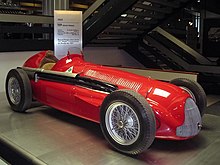

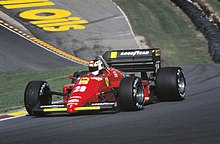
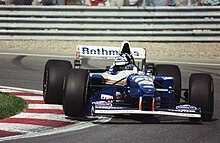



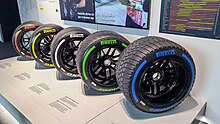











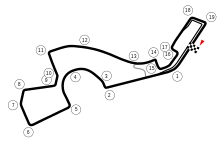




F1 (disambiguation)Formula One (disambiguation)List of FIA championshipsOpen-wheel single-seater Formula auto racingFerrariHonda RBPTMercedesRenaultPirelliMax VerstappenRed Bull RacingMcLarenCurrent seasonHistoryRacingRegulationsPoints scoring systemsRacing flagsEngineCircuitsGrands PrixRed-flagged racesSeasonsDriversChampionsFastest lapsFatalitiesFemale driversGP winnersNumbersPolesittersSprint winnersConstructorsEngine manufacturersRace Promoters' Trophy winnersNational coloursSponsorship liveriesTV broadcastersVideo gamesFIA World Motor Sport CouncilFormula One GroupLiberty MediaFormula One Constructors' AssociationFormula One Teams AssociationGrand Prix Drivers' Associationopen-wheel single-seaterracing carsFédération Internationale de l'Automobilemotorsportinaugural running in 1950formulathe set of rulespoint-systemone for the driversone for the constructorsSuper LicenceFormula One carsroad-coursedownforceunderbody tunnelsaerodynamicssuspensionTraction controllaunch controlautomatic shiftingelectronic driving aidsCVC Capital PartnersHistory of Formula OneWorld Manufacturers' ChampionshipEuropean Drivers' Championship1946 Turin Grand PrixWorld War II1950 British Grand PrixSilverstone CircuitGiuseppe FarinaAlfa RomeoJuan Manuel FangioMichael SchumacherAlfa Romeo 1591958 seasonStirling MossMercedes-BenzMaseratifront-enginedFormula Twodesmodromic valvesfuel injection1955 Le Mans disasterLotus 18NürburgringBugattimid-enginedJack BrabhamFerguson P99four-wheel drive1961 British Grand Prixmonocoquespace-framesponsorship was introduced to the sportTeam GunstonBrabhamprivately enteredGunston1968 South African Grand Prixworks teamBritish racing greenits carsImperial Tobacco1968 Spanish Grand PrixaerofoilsColin ChapmanLotus 491968 Monaco Grand Prixground-effectJim HallChaparral 2Jride heightBernie EcclestoneFédération Internationale du Sport AutomobileFISA–FOCA warJean-Marie BalestreMax MosleyConcorde Agreementground-effect aerodynamicsturbochargedItalian Grand Prix
